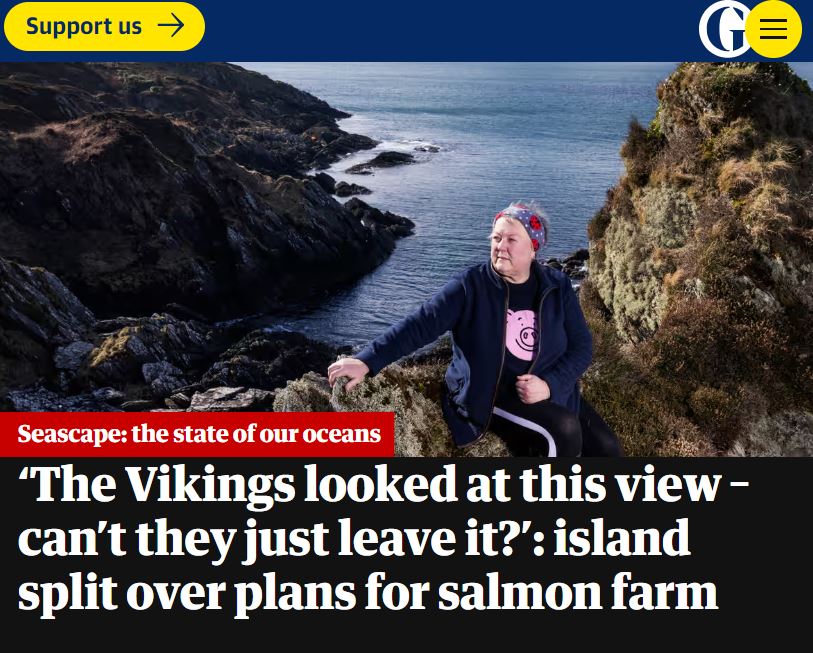 Sjókvíaeldi á laxi klýfur samfélög alls staðar þar sem það er stundað.
Sjókvíaeldi á laxi klýfur samfélög alls staðar þar sem það er stundað.
Í ítarlegri umfjöllun The Guardian er talað við íbúa Gigha, sem er ein Suðureyja (Hebrides) við strendur Skotlands, en þar hefur sjókvíaeldisiðnaðinum tekist að kljúfa samfélagið. Gríðarlegur laxadauði í kvíunum er eitt af því sem íbúarnir setja fyrir sig.
On the west coast, there are just a handful of houses, cliffs and stunning views across the sea to Jura and Islay. But it is here that Bakkafrost, a Faroese salmon company, proposes siting eight 50-metre-wide cages and a feed barge.
“It will be about 100 metres out to sea,” says Stevenson, who is the treasurer of Gigha community council but stresses that she does not speak for them, as she points past the cliffs below. “There is nothing man-made. The Vikings on Gigha looked at the same view – can’t they just leave it this way?”
On this speck of land three miles west of the Kintyre peninsula, fish farming has brought well-paid employment and even a few much-needed newcomers. But Bakkafrost’s plan to site a third farm here has divided the community-owned island.
Despite the promise of five new jobs – a significant number among a population of just 170 – a survey by the community council, a statutory consultee to all planning applications, found 61% of respondents opposed the farm.
Concerns over the proposed new site, on this most southerly of the Hebridean islands, in Argyll and Bute, are not restricted to a spoiled view. John Aitchison, the chair of Friends of the Sound of Jura, a conservation charity based in Argyll, believes warming seas could be posing a bigger threat to salmon welfare in farms in southern and western Scotland than is being acknowledged.
Examination of regional differences in mortalities, from the Scottish government’s latest data on survival rates across a whole production cycle to harvest, “rang alarm bells” for him, he says.
“South and west Scotland had worse mortality than average, with lower mortalities further north,” Aitchison says. “In 2020, there was almost 39% mortality in the Western Isles and 31% mortality in the south-west, compared with around 20% in Orkney and Shetland.”
…
It’s easy to see why the Scottish government might not be keen to curtail the growth of salmon farms. The circles of open-pen salmon farms dotting the sea lochs and jagged shorelines of Scotland’s west coast and islands mark a success story for the aquaculture industry, the fastest-growing food production sector in the world.
Farmed salmon was the UK’s top food export in 2023. The past decade has seen Scotland’s £1.2bn aquaculture sector increase its contribution to the economy by 154% to £472m, surpassing marine fishing at £321m. For the Scottish government, which supports aquaculture within environmental limits, it also brings jobs to rural communities, directly employing 2,300 people and indirectly supporting another 10,000.
However, rising death rates have sparked concern. About one in four Scottish salmon don’t live to harvest and data from the Fish Health Inspectorate reveals a trend of mostly rising mortality levels in seawater in recent years, from just over 4m in 2020 to more than 10m last year.
Campaigners point out that one of Bakkafrost’s salmon units off Gigha, Druimyeon Bay farm, had the highest cumulative mortality of all Scotland’s active fish farms in 2023, at 82.3%, according to industry figures. It is also one of Scotland’s most southerly salmon farms.
…
When annual marine mortalities on salmon farms were 1.6m in 2018, a fraction of what they are today, a Scottish parliamentary inquiry declared them “too high” and that no expansion should be permitted at sites with high mortality levels unless they were addressed by regulators.
On the ferry, Mark Sheldrake, a lobster fisher, says: “I’m all for local employment but I’m concerned about chemicals and I don’t like salmon being crammed into cages.”
